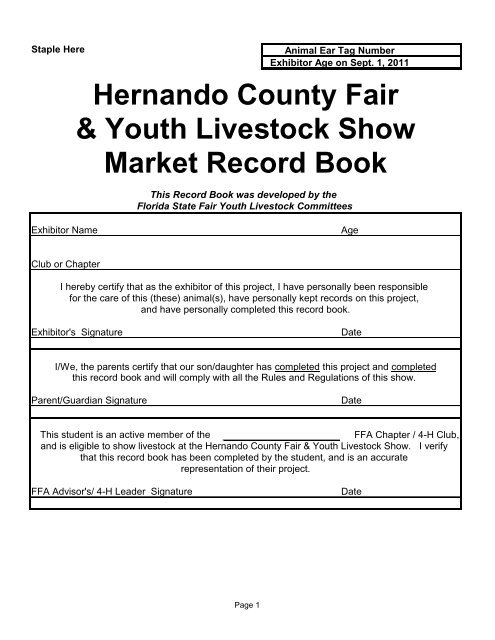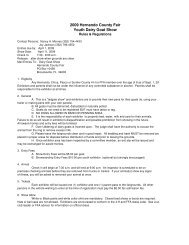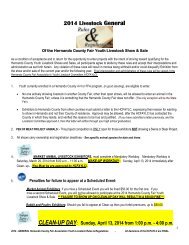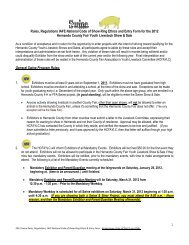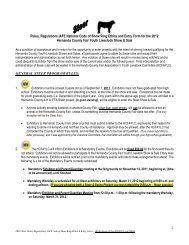Hernando County Fair & Youth Livestock Show Market Record Book
Hernando County Fair & Youth Livestock Show Market Record Book
Hernando County Fair & Youth Livestock Show Market Record Book
Create successful ePaper yourself
Turn your PDF publications into a flip-book with our unique Google optimized e-Paper software.
Staple Here<br />
Exhibitor Name Age<br />
Club or Chapter<br />
Animal Ear Tag Number<br />
Exhibitor Age on Sept. 1, 2011<br />
<strong>Hernando</strong> <strong>County</strong> <strong>Fair</strong><br />
& <strong>Youth</strong> <strong>Livestock</strong> <strong>Show</strong><br />
<strong>Market</strong> <strong>Record</strong> <strong>Book</strong><br />
This <strong>Record</strong> <strong>Book</strong> was developed by the<br />
Florida State <strong>Fair</strong> <strong>Youth</strong> <strong>Livestock</strong> Committees<br />
I hereby certify that as the exhibitor of this project, I have personally been responsible<br />
for the care of this (these) animal(s), have personally kept records on this project,<br />
and have personally completed this record book.<br />
Exhibitor's Signature Date<br />
I/We, the parents certify that our son/daughter has completed this project and completed<br />
this record book and will comply with all the Rules and Regulations of this show.<br />
Parent/Guardian Signature Date<br />
This student is an active member of the<br />
FFA Chapter / 4-H Club,<br />
and is eligible to show livestock at the <strong>Hernando</strong> <strong>County</strong> <strong>Fair</strong> & <strong>Youth</strong> <strong>Livestock</strong> <strong>Show</strong>. I verify<br />
that this record book has been completed by the student, and is an accurate<br />
representation of their project.<br />
FFA Advisor's/ 4-H Leader Signature Date<br />
Page 1
THE PURPOSE OF A MARKET ANIMAL YOUTH PROJECT IS TO ACHIEVE THE FOLLOWING:<br />
1) To acquire an understanding of market animal production by preparing, purchasing,<br />
caring and keeping records on one or more animals.<br />
2) To be able to identify the types and grades of animals and employ efficient methods of<br />
marketing.<br />
3) To understand the business aspects and economics of purchasing animals, feeds,<br />
facilities and equipment for an animal project.<br />
4) To develop integrity, sportsmanship and cooperation.<br />
5) To develop leadership abilities, build character and assume citizenship responsibilities.<br />
It is very important that every section of this record book be complete and accurate.<br />
<strong>Record</strong> <strong>Book</strong> must be complete or entry will be denied.<br />
Signature of student<br />
Signature of parent/guardian<br />
PURPOSE<br />
DRUG STATEMENT<br />
THIS IS TO ACKNOWLEDGE THAT I HAVE BEEN ADVISED THAT THE PRESENCE OF<br />
ANY DRUG, ANTIBIOTIC OR BIOLOGICAL RESIDUE IN MY MARKET ANIMAL AT<br />
SLAUGHTER WILL RESULT IN THE CONDEMNATION OF THE CARCASS AND<br />
FORFEITURE OF ALL SALE PROCEEDS AND PREMIUMS.<br />
I HEREBY CERTIFY THAT ANY DRUG, ANTIBIOTIC, OR BIOLOGICAL RESIDUE WHICH<br />
MAY HAVE BEEN ADMINISTERED BY MYSELF, OR ANY OTHER PERSON, WAS DONE<br />
SO IN STRICT COMPLIANCE WITH THE MANUFACTURERS' LABEL REQUIREMENTS<br />
OR AS PRESCRIBED BY A VETERINARIAN..<br />
Page 2
Notes from the judge:<br />
1) Your <strong>Record</strong> <strong>Book</strong> should start on the initial check in date of your animal.<br />
2) <strong>Record</strong> <strong>Book</strong>s should be completed on animal relating to your animal project<br />
3) The only item that you should submit at check in is the record book. Please do not<br />
make it a scrapbook. Do not take pages apart.<br />
4) The completed record books MAY be placed in 3 ring binder, no larger than 1".<br />
5) Always double-check your work, especially your math calculations.<br />
6) Have someone check your project story for spelling and grammar before you write it<br />
in the final record book.<br />
7) All feed used in the project should be expressed in pounds, not units(bales, bags, etc…)<br />
8)<br />
<strong>Youth</strong> <strong>Livestock</strong> <strong>Market</strong> <strong>Record</strong> <strong>Book</strong> Guide Lines:<br />
It is suggested that a copy of the record book be made for use as a work copy.<br />
<strong>Record</strong>s can then be transferred into this book for a Final Copy.<br />
If the incorrect record book is used, the exhibitor may be disqualified from the<br />
record book contest.<br />
Page 3
Item Description Date Acquired<br />
PROJECT INVENTORY<br />
List all equipment and assets you had at the beginning of the project. After listing existing<br />
inventory, you should also list those items you purchased this year that you will keep after<br />
the project is finished. List items you will keep past the end of this project on this page only<br />
(inventory items include clippers, blowers, chutes, tack, etc.) DO NOT list expendable items<br />
such as shampoo, etc. Refer to Project Terms and Explanation, page 17, for descriptions of<br />
each column. Items should be listed in chronological order<br />
Total Depreciation<br />
(Depreciation is an Expense)<br />
Value at End / Total<br />
Assets<br />
XXXXX<br />
XXXXX<br />
Purchase Value at<br />
Cost or beginning<br />
Value of project<br />
A B<br />
XXXX<br />
XXXX<br />
Page 4<br />
XXXX<br />
XXXX<br />
Depreciation (10% of<br />
purchase cost [A]<br />
per calendar year)<br />
C<br />
XXXXX<br />
Value at end<br />
of project<br />
(B minus C)<br />
D<br />
XXXXX
If animal is purchased by the head, estimate weight. To calculate the Price Per Pound of an<br />
animal purchased by the head - divide the cost by the estimated weight.<br />
Date Description<br />
Paid To<br />
. Cost of Animal<br />
Date<br />
Weight Price Per Total<br />
Pound Cost<br />
NON-FEED EXPENSES<br />
List everything that you spend money for that you will NOT have at the end of the project and that<br />
is NOT feed or hay. This includes entry fees, veterinary expenses, bedding, marketing costs and<br />
other expendable items such as shampoo, shoe polish, hair spray, film, developing. etc.<br />
LIST ITEMS YOU WILL KEEP PAST THE END OF THIS PROJECT ON THE PROJECT<br />
INVENTORY PAGE ONLY (Inventory examples include clippers, blowers, chutes, tack, etc.)<br />
Description<br />
ANIMAL EXPENSE<br />
Total Non-Feed Expenses<br />
Page 5<br />
Purchased by the Head?<br />
Yes or No<br />
Paid To<br />
Total Cost
Date<br />
Value of All Feedstuffs Used in Project<br />
List all feed and hay on this page (list each feed purchase separately.)<br />
Description Paid To/Donated by Pounds of Feed Total Value of Feed<br />
Page Total - Pounds of Feed<br />
Page Total - Feed Value<br />
Page 6<br />
XXXXX<br />
XXXXX
Date<br />
Value of All Feedstuffs Used in Project<br />
List all feed and hay on this page (list each feed purchase separately.)<br />
Description Paid To/Donated by<br />
Pounds of Feed<br />
Total pounds of Feed page 6<br />
Total pounds of Feed page 7 +<br />
Total pounds of Feed =<br />
Total Feed Value page 6 $_________<br />
Total Feed Value page 7 +<br />
Total Feed Value =<br />
Total Value of Feed<br />
Page Total - Pounds of Feed XXXXX<br />
Page Total - Feed Value XXXXX<br />
Page 7
OTHER INCOME<br />
Other project income should be recorded here, such as show premiums or other money earned.<br />
Date<br />
If you have no other income from this project prior to the show, THEN ENTER ZERO.<br />
Description<br />
Total other income, if none, enter zero<br />
Sponsor Income<br />
You should record here any money given to you, to support your project, by sponsors.<br />
Sponsor's Name<br />
Total Sponsor Income, if none, enter zero<br />
Page 8<br />
Total<br />
Total
Total Number of days on feed<br />
Date<br />
WEIGHT RECORDS<br />
Keep track of the weight gains of your animal. Be sure to include the beginning weight and your<br />
Total Gain<br />
final weight at <strong>Fair</strong> check-in. If you do not have access to scales, use a weight tape.<br />
* Average Daily Gain can be calculated by taking the pounds gained since last weighing,<br />
Date<br />
Beginning Weight<br />
divided by the number of days since last weighing.<br />
Weight<br />
Pounds Gained Since<br />
last weighing<br />
HEALTH RECORD<br />
Number of days<br />
since last weighing<br />
Average Daily<br />
This should include a record of any health related activities (deworm, vaccinate, or use of<br />
veterinarian's services for any other reason). This should include what you used, how much<br />
you used, and what you used it for. Include well animal care (such as health certificate).<br />
Fill in all applicable information.<br />
If animal healthy throughout project, make note of that.<br />
Description of Activity Product Used Dosage Withdrawal Time<br />
Page 9<br />
Gain
PROJECT SUMMARY<br />
GAIN<br />
Beginning Weight (From Page 5) 1<br />
Final Weight (at <strong>Fair</strong> Check-In) (From Page 9) 2<br />
Total Gain (From Page 9) 3<br />
Total Number of Days on Feed (From Page 9) 4<br />
Final Average Daily Gain (Explained on Page 17) 5<br />
FEED<br />
Total Pounds of Feed Fed (From Page 7) 6<br />
Total Feed Value (From Page 7) 7<br />
Conversion (Pounds of feed fed per pound of gain)<br />
(See Page 17 for Explanation)<br />
Cost of Gain (Value of feed per pound of gain)<br />
8<br />
(See Page 17 for Explanation) 9<br />
INCOME<br />
Other Income (From Page 8) 10<br />
Sponsor(Add-on) Income (From Page 8) 11<br />
TOTAL PRELIMINARY INCOME (Line 10 + 11) 12<br />
EXPENSES<br />
Total Depreciation (From Page 4) 13<br />
Cost of Animal (From Page 5) 14<br />
Total Non-Feed Expenses (From Page 5) 15<br />
Total Value of Feed (From Page 7) 16<br />
TOTAL EXPENSES (Line 13 + 14 + 15 + 16) 17<br />
PRELIMINARY PROFIT/LOSS<br />
(Lines 12 minus 17) 18<br />
SUMMARY (To be completed after the fair-leave 19 thru 21 blank until then)<br />
Animal Premiums (contact <strong>Fair</strong> Office) 19<br />
Sale Price (final weight x actual price received) 20<br />
FINAL PROFIT / LOSS (Line 12 + 19 + 20 - 17) 21<br />
TOTAL ASSETS (From Page 4) 22<br />
Page 10
PICTURES OF YOUR PROJECT<br />
<strong>Show</strong> the beginning and end of your project along with two different skills that you have learned.<br />
This should include a minimum of 5 pictures and a maximum of 8 pictures. Include a caption with<br />
each photo. The captions should tell a story. The pictures and captions should compliment your<br />
project story. Explain what you are doing and why you are doing the things shown in the picture.<br />
What skills are you demonstrating and why? Spelling and grammar is considered.<br />
Beware of not displaying any unsafe practices in your pictures.<br />
Page 11
Pictures (continued):<br />
Page 12
Pictures (continued):<br />
Page 13
PROJECT STORY OUTLINE<br />
You will make an outline for your project story first. It should include what you have learned about<br />
your animal, what safety practices you used in your project, what you could do to improve your<br />
project and the different skills that you used in your project. This is an outline form - complete<br />
sentences are not necessary. All outline sub-topics must be complete to receive full points.<br />
I. Introduction - Introduce your story and capture the reader's interest.<br />
II. What did I learn?<br />
A.<br />
B.<br />
C.<br />
III. What safety practices did I use?<br />
A.<br />
B.<br />
C.<br />
IV. What improvements could I make?<br />
A.<br />
B.<br />
C.<br />
V. What skills did I learn or improve?<br />
A.<br />
B.<br />
C.<br />
VI. Summary - Leave the reader with the idea or impression you want them to have.<br />
Page 14
Use the outline to write your story.<br />
PROJECT STORY<br />
Your project story must be developed from your outline. Use stories to make a point, use<br />
examples, use interesting facts or statistics, remember your experiences, build strong images<br />
by using descriptive words. Be sure to use transition words to connect your ideas. (Examples:<br />
first, second, another, also, however, for instance, finally, for example, in conclusion, etc.)<br />
Grammar, spelling and neatness will be noticed by the judges.<br />
Page 15
PROJECT STORY (continued)<br />
Page 16
Notes for Project Inventory (page 4) -<br />
1) Project Year - Based on a calendar year. Current project year is same year as current <strong>Fair</strong>.<br />
2) Date acquired - List the date you obtained this item, on items older than 1 year, the year will be sufficient.<br />
3) Purchase cost or value - What did this item cost when you obtained it? (<strong>Fair</strong> market value)<br />
4) Value at Beginning of Project- Same as purchase cost for items purchased current calendar year. On items from previous<br />
years this should be the value from last year's ending inventory or depreciated value of 10% of purchase cost per project year.<br />
5) Depreciation of 10% - This will be 10%, per calendar year, of the original purchase cost for the items you will still have at the<br />
end of the project. This includes items you had at the beginning of the project as well as items purchased during the current<br />
calendar year. Depreciation is the loss in value of your assets and is an expense.<br />
6) Value at the end of the project- This is the value at the beginning of the project minus the depreciation.<br />
NOTE: Depreciation is an expense<br />
Notes for Project Summary Page -<br />
Total Gain - Final weight minus beginning weight.<br />
Project Terms and Explanations<br />
Final Average Daily Gain (ADG) - Total Gain divided by the total number of days on feed.<br />
Use number of days from date you purchased your animal to date of final check-in.<br />
Conversion - Pounds of Feed (FED) per pound of gain - Total pounds of feed fed divided by the total gain.<br />
Cost of Gain - Total feed cost divided by total gain.<br />
ALL Donations have value and MUST be included as income on Page 8 under Sponsor Income.<br />
If the project animal is donated, then a 0 will be placed for animal expense and value of animal is listed on Page 8.<br />
If feedstuffs are donated then, then a 0 is placed for feedstuff value and value of feedstuffs is listed on Page 8<br />
Page 17
Name<br />
Ear Tag #<br />
1 Signatures (Cover) 2<br />
2 Drug Statement (Page 2) 2<br />
3<br />
4<br />
5<br />
6<br />
7<br />
8<br />
9<br />
10<br />
11<br />
12<br />
13<br />
Judge's Tally Sheet<br />
<strong>Market</strong> Animals<br />
Jr. I. Sr.<br />
Section Points Possible Points Earned<br />
Inventory (Page 4) 10<br />
Animal & Non Feed Expenses (Page 5) 4<br />
Feed Expenses (Page 6 & 7) 10<br />
Income (Page 8) 2<br />
Weight <strong>Record</strong>s (Page 9) 10<br />
Health <strong>Record</strong>s (Page 9) 2<br />
Project Summary (Page 10) 18<br />
Pictures (Page 11, 12 & 13) 15<br />
Project Story Outline (Page 14) 5<br />
Project Story (Page 15 & 16) 10<br />
Neatness & Accuracy 10<br />
Total Points 100<br />
Page 18


